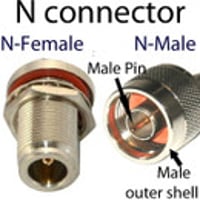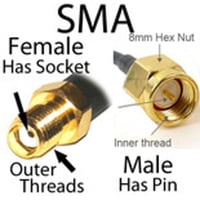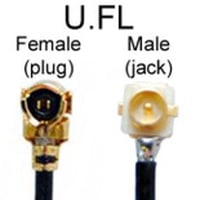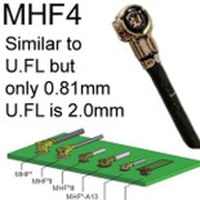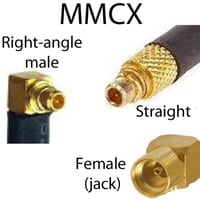Antennas with N-female Connector
Antennas with an N female Connector:
N-female is the most weatherproof antenna connector type, because it is nickel-plated and is the best connector for outdoor applications.
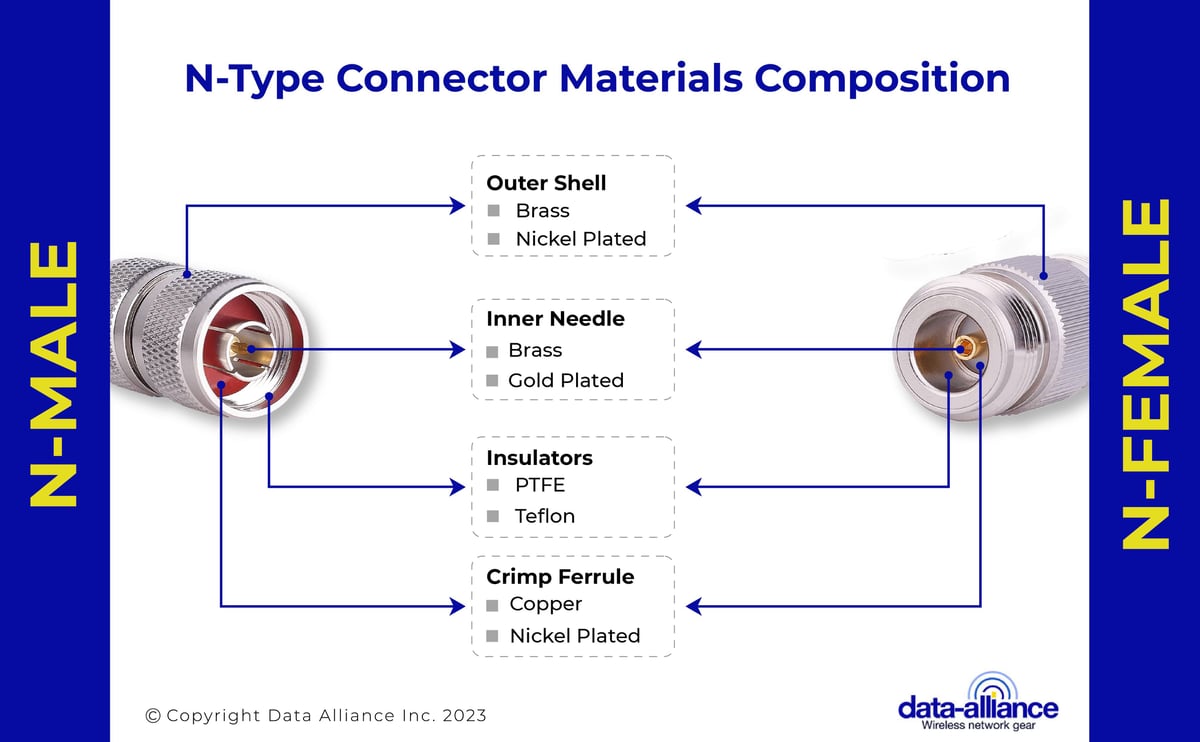
An N female connector antenna is an antenna that is terminated with a female N connector. N connectors are a type of coaxial connector in widespread use for wireless and cellular networking in a range of environments. On antennas, an N female connector provides not only an electrical but also a physical point of connection for the antenna and can be used to attach the antenna to a coaxial antenna cable with a complementary N connector or directly onto a radio device. The N connector is compatible with a range of miniature to medium-sized coaxial cables.
The N connector is also known as the Type N connector, or Navy connector. It was designed by and named after Paul Neill of Bell Labs who invented it in the 1940s. The N connector is a threaded, medium-sized connector, which was one of the first radio frequency connectors capable of transmitting microwave-frequency signals reliably. The military specification MIL-C-39012 specifies its characteristics and performance. Its larger size, in comparison to sub-miniature coax connectors like the SMA connector, makes it easier to handle and more robust, especially in outdoor installations.
Specifications of the N female connector
- Physical specs: Female N connectors consist of a brass body that is often plated with nickel. It is a barrel-shaped threaded connector with a diameter of 0.620 inches (1.57 centimeters). Its 5/8-24 United Extra Fine pitch threading is externalized, permitting the male connector to screw down onto it. The female N connector’s inner mating interface consists of phosphor bronze or beryllium copper receptacle which may be silver or gold plated. It uses air as an insulator, though some contemporary designs have a partial Teflon insulator. The receptacle can be slotless or a slotted captivated contact. It can also carry a silicone rubber gasket that aids in weatherproofing. The mated connection of the N-type female connector with its male counterpart can be appropriately hand tightened via the grip on the male connector and is rated for at least 500 mating cycles.
- Electrical specs: The Type-N connector is widely available as a 50 Ohm connector, though 75 Ohm versions are also available. The 50 Ohm connector that is found on N female antennas is unlikely to be compatible with a 75 Ohm connector without damage. The original N connector was able to support frequencies up to 1 GHz, but contemporary designs targeting the wireless networking sector have been modified to handle up to 18 GHz. This performance is in part attributable to its VSWR of between 1.2 and 1.35 (depending on the manufacturer), and low insertion loss and radio frequency leakage of -90 dB at 3 GHz. They are capable of withstanding voltages up to 1500 Volts.
With female N connector antennas, the N connector is connected to the antenna cable within the antenna radome. This is done by soldering the center conductor of the antenna securely to the center conductor within the female N connector. Soldering is the preferred method for the join as it imparts mechanical strength and is unlikely to deteriorate with repeated use of the antenna.
Why are N female connector antennas important for Outdoor Applications
- N female connector antennas are rugged, larger, and heavier
As a medium-sized connector, N connectors are durable connectors that can handle the challenges of deployment in emergencies or challenging environments. A larger connector on an antenna is often advantageous, even though it is heavier and will take up more space on a radio device. It is better able to withstand rough handling and has less risk of mechanical failure.
- N female connector antennas deliver reliable performance
The N connector was originally designed for military use and is capable of supporting high power and high throughput connectivity in harsh, exposed conditions including extremes of temperature, moisture, vibration, and shocks. N-type connector antennas are ideal for outdoor environments as the connector is resilient against degradation of power, data, or signal transmission.
- Nickel-plated brass on N female connector antennas add to the durability of the antenna
Nickel-plated brass female N connectors are resistant to wear and have good longevity compared to many other materials as well as providing good conductivity and signal stability.
- N female connector antennas are easy to handle
Connecting the N female connector to a cable or a device is straightforward. It can usually be hand tightened to the appropriate level of torque, though some complementary male N connectors can carry a hex nut for tightening with a wrench.
- Threaded N female connector antennas provide a robust connection
Threaded antenna connectors are an extremely reliable type of connection that delivers a stable and stationary connection. It can withstand impacts and vibration, especially those caused by the attached cable. A threaded connection also facilitates a secure connection to panels or mounting panels and carries significant mechanical strength. Properly tightened
- N female connector antennas can withstand a high number of mating cycles
The number of mating cycles of a connector counts the number of times a connector can be reliably connected and disconnected without degrading its specifies mechanical and electrical performance and is a strong indicator of the longevity of the connector. N connectors are typically rated for 500 mating cycles meaning that an N connector antenna should be able to perform reliably in situations where repeated connection and disconnection may be likely. Good quality N connectors have robust and well-plated inner contacts which greatly affect the mating cycles possible. Beryllium copper and phosphor bronze connectors are durable and able to last for a high number of cycles.
- N female connector antennas are weather-resistant
The physical properties and resilience of the N connector as described above means that it excels as a weather-resistant radio frequency connector for outdoor antennas or cable assemblies. The silicone rubber O-ring of the connector provides a seal on the coupling that is moisture, dirt, and debris proof up to an IP67 rating in certain antennas.
Types of N-type female connector antennas
N connector antennas are particularly used for outdoor antenna installations and span a range of applications and frequencies including wireless LAN, cellular communication, Amateur (Ham) radio, and GPS. The most common types of N female connector antennas include:
[A] Omnidirectional N-type female connector antennas produce 360-degree coverage around the antennas longitudinal axis. When mounted at height, omnidirectional N female connector antennas are capable of providing point to multipoint connectivity over a significant range, while the robust connector can support mounting arrangements as described below.
[B] Directional N female connector antenna have varying degrees of directivity and gain. They focus their transmitting and receiving power in a single direction meaning that they can be used for high throughput wireless links that can cover significant distances.
[C] Yagi antennas with N female connectors are a type of directional antenna that has a distinctive structure. They are composed of paired dipoles arranged along a single axis, sometimes with a reflector. One of the dipole pairs known as the driven element is powered and the remaining metal rods are passive. They may come with a radome for added weather resistance.
[E] Panel antennas with an N-type female connector have the directional antenna elements housed behind a flat reflector and are ideal for point to point connectivity.
[F] Co-linear array antennas with N female connectors are omnidirectional antennas that are made up of multiple elements arranged around a central feed. They are usually sealed in a cylindrical fiberglass radome.
[G] N female connector parabolic antennas have a grid or dish-like structure behind the antenna to increase the focusing of the transmitted or received signal. They are often high gain and ideal for high-throughput wireless links and bridges.
Frequently asked questions
How are N-type female connector antennas mounted?
The ruggedness of the threaded N connector makes it an ideal connector type for secure through-hole mounting, that can withstand the challenges of the outdoor environment. There are a variety of N female style mounts including:
- Bracket mounting (L-mount)
- Wall mounting
- Mast and pipe mounting
- Roof mount kits
For vehicle mounting, there are also magnetic mounts and permanent hole mounts which offer quick and accessible connection of an N connector antenna.
If you are mounting the antenna at height, the antenna will need to be mounted within a mounting bracket, which may also include a hose clamp depending on the type of antenna. Care must be taken when positioning the antenna to ensure that it is adjusted properly according to its polarization.
Most N female connector antennas can be mounted by placing the connector end of the antenna through the hole in the antenna bracket. If the bracket has pipe clamps, these are attached to grooves on the bracket. The bracket may be wall-mounted or attached to a mast or pole, taking care that the top surface of the mounting mast does not exceed the top surface of the bracket. The cable can then be attached to the antennas connector, via an N male connector or an N-type adapter.
Safety is essential for mounting an outdoor N female connector antenna!
There are some risks associated with mounting outdoor antennas, especially at height.
- Do not attempt to install an antenna in wet, windy, or stormy weather.
- Pay attention to your footwear, rubber soles and heels are safest.
- Wear rubber gloves to handle all equipment. The antenna, its mounting and masts are capable of creating an electrical path to ground through you while being handled if they come into contact with a power line.
- If any part of your installation comes into contact with a power line, do not try to touch or move it in any way. Contact emergency services to explain the situation for expert assistance.
In Summary
The N female connector offers many advantages as an antenna connector for outdoor wireless networking. With a range of antenna types and mounting options available, N female connector antennas are straightforward, easy to handle, and provide the durability needed for long-term outdoor antenna installations.
LEARN MORE:
- Mounts for antennas with N female connector
- N male connector antennas
- N connector cables and adapters

